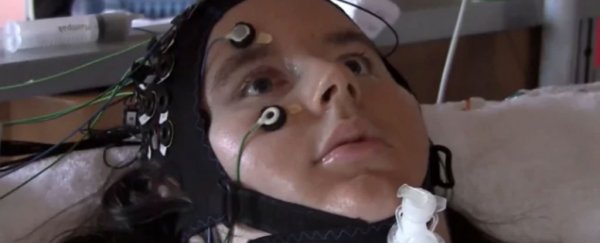The technology to control a computer using only your thoughts has existed for decades. Yet we've made limited progress in using it for its original purpose: helping people with severe disabilities to communicate. Until now, that is.
A new study has shown that an alternative brain-computer interface technology can help people with 'locked-in syndrome' speak to the outside world. It has even allowed sufferers to report that they are happy, despite the condition.
The final stages of the degenerative condition known as amyotrophic lateral sclerosis (ALS) or motor neuron disease, leaves sufferers in a complete locked-in state. In the end they cannot move any part of their bodies, not even their eyes, although their brains remain unaffected.
But scientists have struggled to use brain-computer interface technology that measures electrical activity in the brain to help them communicate.
One reason for this is that it is still unclear how much these conventional brain-computer interface systems rely on electrical signals that are generated by the movement of eye muscles.
One ALS sufferer who had been using a brain-computer interface when she could still move her eyes lost her ability to communicate through the technology after becoming completely locked-in.
This suggested that most of the electrical activity recorded by the computer was related to involuntary eye movements that occurred when she thought about something rather than the thoughts themselves.
To overcome this problem, an international group of researchers used a different way of detecting neural activity that measures changes in the amount of oxygen in the brain rather than electrical signals.
The research, published in PLOS Biology, involved a technique known as functional near-infrared spectroscopy, which uses light to measure changes in blood oxygen levels.
Because the areas of the brain that are most active at any given time consume more oxygen, this means you can detect patterns of brain activity from oxygen fluctuations.
This technique is not as sensitive to muscular movements as the electroencephalography (EEG) systems used to measure electrical activity.
This means the new method could be used to help ALS sufferers communicate both before and after they lose their entire ability to move because it is more likely to only record brain activity related to thoughts.
The study involved four ALS sufferers, three of which had not been able to reliably communicate with their carers since 2014 (the last one since early 2015).
By using the new brain-computer interface technology, they were able to reliably communicate with their carers and families over a period of several months. This is the first time this has been possible for locked-in patients.
The volunteers were asked personal and general knowledge questions with known "yes" or "no" answers.
The brain-computer interface captured their responses correctly 70 percent of the time, which the researchers argued was enough to show they didn't just record the right answer by chance. Similar experiments using EEG didn't beat this chance-level threshold.
The patients were also able to communicate their feelings about their condition, and all four of them repeatedly answered "yes" when they were asked if they were happy over the course of several weeks.
One patient was even asked whether he would agree for his daughter to marry her boyfriend. Unfortunately for the couple, he said no. The volunteers have continued using the system at home after the end of the study.
As I know from my own research, working with completely locked-in patients requires a lot of hard work. In particular, you can't know for sure if the user has understood how we want them to give an answer that we can try to detect.
If a system that has previously been used to record the brain activity of able-bodied users doesn't work with locked-in patients, it is common to assume that the person, and not the machine, is at fault, which may not be the case.
What's more, there is added pressure on researchers – from the patient's family and from themselves – to fulfil the dream of finding a way to communicate with the volunteers.
These challenges highlight what a significant achievement the new study is. It is a groundbreaking piece of research that could provide a new path for developing better brain-computer interface technology.
Even though the system so far only allows locked-in patients to give yes or no answers, it already represents a big improvement in quality of life.
The first ever brain-computer interface system was designed to enable disabled (although not locked-in) users to spell words and so communicate any message they wanted, admittedly through a slow and lengthy process.
So it is safe to assume that the new technology is just the first step towards more sophisticated systems that would allow free two-way communication not based on simple questions.
Perhaps more importantly, the technology has already restored the communication capabilities of four people who had been mute for years. Imagine how these patients and their families must have felt when they were finally able to 'speak' again.
Despite the challenges in brain-computer interface research, results like this are what make us keep going.
![]()
Ana Matran-Fernandez, Post-doctoral Researcher, University of Essex.
This article was originally published by The Conversation. Read the original article.
